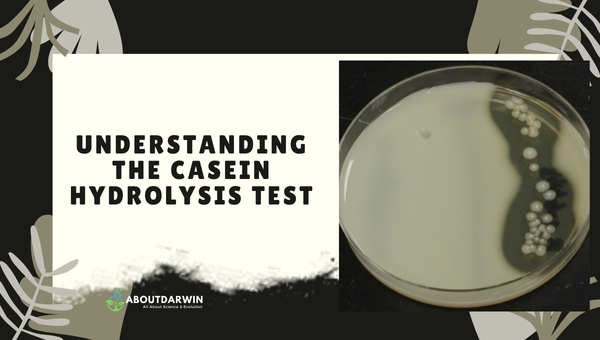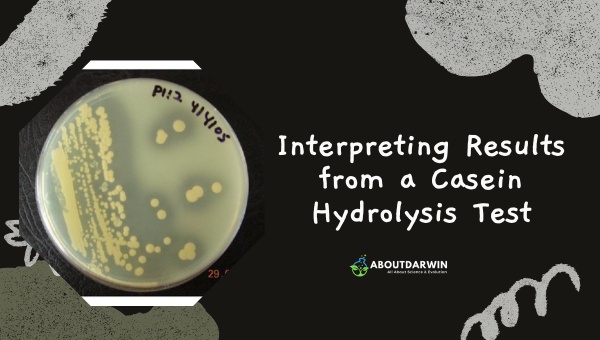Physical Address
304 North Cardinal St.
Dorchester Center, MA 02124
Diving into the incredible world of microbiology, today, we’ll be exploring an interesting and widely used test known as the Casein Hydrolysis Test.
Often used in science labs around the world, this procedure helps in identifying bacteria capable of producing extracellular enzymes that catabolize casein. Now you might be wondering, what is casein? Well, it’s a milk protein that gives milk its white color.
As we embark on this exploratory journey, we’ll delve into the nuts and bolts of this test – how it works on a molecular level, the step-by-step process of conducting it appropriately, and its relevance across various fields.
We’ll also decipher how to interpret results accurately to draw meaningful conclusions. So buckle up and get ready for an exciting ride into the realm where science meets practical application!
Contents
When it comes to microbiological tests, the Casein Hydrolysis Test distinguished itself as a fascinating assessment procedure. It’s a distinctive method utilized to identify and isolate bacteria capable of producing caseinase, an enzyme that breaks down casein. This protein, predominantly found in milk, is responsible for its opacity and color.

To understand this better, picture the science behind it: The bacterium with caseinase production capability disintegrates the milk protein into smaller molecules such as peptides and amino acids. The organism easily absorbs these nutrients.
This hydrolysis process can be visually tracked on a nutrient-rich medium. Moving ahead, let’s get our hands into the nitty-gritty of why it’s crucial and how this test is performed effectively.
To get a grasp on the science behind a casein hydrolysis test, we first need to dive into the world of proteins. Imagine proteins like a puzzle; they are made up of smaller pieces called amino acids. In our case, the “puzzle” or protein we’re focusing on is casein, the protein that gives milk its iconic white color.
When bacteria produce an enzyme known as caseinase, it’s like they have just found that one edge piece of a puzzle that lets them start to break it apart. Caseinase acts as molecular scissors, breaking down the large casein protein into smaller peptides and amino acids.
These microorganisms can readily use these broken-down particles for their metabolic processes. The very presence of these “scissors” indicates specific bacterial strains capable of digesting casein – and that’s what our test identifies with precision.
The fundamental principle underlying a casein hydrolysis test is both intriguing and straightforward. Picture a culinary scene where the chef is using a food processor to break down larger food items into smaller, digestible pieces. The enzyme caseinase acts similarly on casein protein contained in milk or similar mediums.
Working at the molecular level, this specific test leverages bacterial colonies cultured on a medium rich with casein protein. Bacteria that produce the enzyme caseinase can hydrolyze these proteins, breaking them down into manageable amino acids and peptides.
This enzymatic reaction causes an observable clear zone around the colony on the otherwise milky white agar plate, indicating that casein has been consumed – bingo! This visual change helps us identify specific bacteria capable of producing this enzyme – simple.
Also Read: Unraveling Potato Dextrose Agar (PDA): Principle & More
Conducting a casein hydrolysis test involves initial preparation, such as sterilizing equipment and preparing bacteria cultures. The apt execution phase requires you to streak the prepared culture onto a casein agar plate and incubate it under specific conditions.
After incubation, the interpretation of clear zones surrounding bacterial growth determines the presence of caseinase-producing microbes.
Before we start with the actual test, there are a few preparatory steps to ensure the process runs smoothly. One of them is assembling all materials and ensuring they’re sterilized to prevent any unwanted contamination influencing our results – like an unexpected visitor at a dinner party throwing off your dinner plans!
Next, prepare your bacterial cultures. You’ll incubate these cultures overnight to allow adequate growth before introducing them to the casein agar plates. Also, remember to prepare these casein agar plates in advance – they provide a perfect stage for our bacteria starlets to showcase their performance.
Now, onto the center stage! To conduct the casein hydrolysis test itself, follow these steps.
Remember that following every step accurately ensures reliable results – no shortcuts! Just as creating a mouth-watering lasagna involves meticulous attention to each stage within its recipe!
Also Read: Exploring Differences: Gram Positive vs Gram Negative Bacteria
When it comes to the applications of the Casein Hydrolysis Test, you might be surprised. Its usefulness goes far beyond just microbiology labs experimenting with bacteria cultures. From industries ensuring product quality to medical facilities testing for infections, the uses are varied and wide-reaching.
Consider industries like food and beverage, dairy, or even biotechnology that regularly use casein hydrolysis tests in their operations. Take cheese manufacturing as a real-life example. This industry relies on casein hydrolyzing enzymes produced by certain types of bacteria crucial for creating various flavors and textures in cheeses!
In biotechnology sectors, companies developing protein-based therapeutic agents require an understanding of how proteins such as casein can be broken down. Hence, they utilize these tests not only for development but also for quality checks.
On another front, this test’s medical implications cannot be overstated. With evolving bacterial strains causing numerous health issues globally, it aids in diagnosing specific bacterial infections.
While certain bacteria species produce enzymes capable of breaking down proteins like casein, others do not. This characteristic can assist healthcare professionals in identifying disease-causing bacterial strains responsible for particular infections accurately!
Considering everything we’ve covered so far about the Casein Hydrolysis Test’s intricacies should give you a clear understanding as to why this test is just too important to dismiss from utility scenes!
Also Read: All About Lightning: The Power of Nature’s Light Show
While conducting a test like casein hydrolysis is half the work, the real juice lies in correctly interpreting the results.

Whether you’re scanning it for clear zones or trying to figure out a negative impact, each interpretation helps you understand these microscopic creatures better!
Positive results appear when there’s a clear zone surrounding bacterial growth on your casein agar plate. This means that the bacteria culture you have tested is capable of producing caseinase enzyme – our protein “scissors.”
These bacteria are breaking apart large casein proteins and using up these simpler components for their metabolic needs. It’s as if they are inviting themselves to an open buffet and relishing it to their heart’s content!
But on the flip side, any absence of clear zones around bacterial growth indicates a negative result. What this implies is that particular species of bacteria cannot produce sufficient amount or sometimes any caseinase enzyme at all – in this case, no scissors to break down our protein puzzle!
The reasons might be varied: perhaps this bacterial type does not have genetic resources for producing such enzymes, or maybe their metabolic requirements can be fulfilled by other available nutrients in the medium.
Interpreting correct positives from negatives in the Casein Hydrolysis Test could help distinguish between similar-looking bacterial strains with vastly different enzyme production capabilities – all part of larger puzzles we continue to solve!
Also Read: Isostatic Rebound: Uncovering Post-glacial Rebound Process
Precautions are mainly aimed at preventing contamination and ensuring personal safety. Proper sterilization of equipment, maintaining sterile working conditions, and adequate disposal of cultured plates are critical. Always remember to use protective gear!
Most commonly, visible results can take around 24-48 hours post-incubation at an optimal temperature. However, some slow-growing bacteria might show clearer zones even after several days.
The tests themselves don’t have side effects per se, but mishandling microbial cultures or exposure could result in accidents or contamination.
This test is essential as it helps identify specific kinds of bacteria that produce caseinase enzyme – an important aspect when diagnosing certain bacterial infections. It improves accuracy in diagnosing diseases by confirming specific enzyme production capabilities!
Also Read: Unveiling Negative Staining: Principles, Reagent and Results
In our fascinating exploration of the Casein Hydrolysis Test, we’ve journeyed through its underlying science, the hands-on procedure, and practical applications in varied fields, along with interpreting results accurately.
This test not only provides an insightful way of understanding how bacteria interact with their environment but also enables us to identify and isolate specific bacterial strains.
Whether we’re peering under a microscope in a lab or reading about this in classrooms or articles like this one, it reminds us just how interconnected our world can be – right down to a microscopic level! As we continue unraveling mysteries lying within these micro realms, tests like Casein Hydrolysis are essential tools illuminating our path!